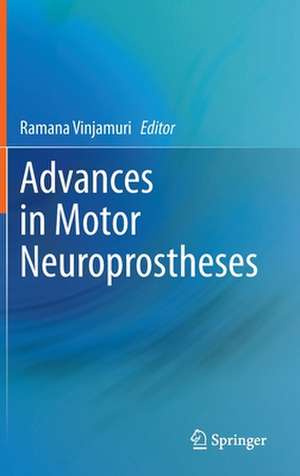Advances in Motor Neuroprostheses
Editat de Ramana Vinjamurien Limba Engleză Hardback – 10 apr 2020
| Toate formatele și edițiile | Preț | Express |
|---|---|---|
| Paperback (1) | 1087.66 lei 6-8 săpt. | |
| Springer International Publishing – 10 apr 2021 | 1087.66 lei 6-8 săpt. | |
| Hardback (1) | 1094.60 lei 6-8 săpt. | |
| Springer International Publishing – 10 apr 2020 | 1094.60 lei 6-8 săpt. |
Preț: 1094.60 lei
Preț vechi: 1152.22 lei
-5% Nou
Puncte Express: 1642
Preț estimativ în valută:
209.48€ • 217.89$ • 172.94£
209.48€ • 217.89$ • 172.94£
Carte tipărită la comandă
Livrare economică 14-28 aprilie
Preluare comenzi: 021 569.72.76
Specificații
ISBN-13: 9783030387396
ISBN-10: 3030387399
Ilustrații: XII, 162 p. 57 illus., 47 illus. in color.
Dimensiuni: 155 x 235 mm
Greutate: 0.43 kg
Ediția:1st ed. 2020
Editura: Springer International Publishing
Colecția Springer
Locul publicării:Cham, Switzerland
ISBN-10: 3030387399
Ilustrații: XII, 162 p. 57 illus., 47 illus. in color.
Dimensiuni: 155 x 235 mm
Greutate: 0.43 kg
Ediția:1st ed. 2020
Editura: Springer International Publishing
Colecția Springer
Locul publicării:Cham, Switzerland
Cuprins
Chapter 1: Application of reinforcement and deep learning techniques in brain machine interfaces.- Chapter 2: Specific muscle activation patterns in athletic and orthopedic populations: considerations for using surface electromyography in assistive and biofeedback device applications.- Chapter 3: Kineto-dynamic modeling of human upper limb for robotic manipulators and assistive applications.- Chapter 4: Learning from the human hand: force control and perception using a soft-synergy prosthetic hand and non-invasive haptic feedback.- Chapter 5: Design of a soft glove-based robotic hand exoskeleton with embedded synergies.- Chapter 6: Model predictive control based knee actuator allocation during a standing-up motion with a powered exoskeleton and functional electrical stimulation.- Chapter 7: Deep brain stimulation for gait and postural disturbances in Parkinson’s disease.- Chapter 8: Cognitive and physiological intent for the adaptation of motor prostheses.- Index.
Notă biografică
Ramana Vinjamuri received his undergraduate degree in Electrical Engineering from Kakatiya University (India) in 2002. He received his MS in Electrical Engineering from Villanova University in 2004 specialized in Bioinstrumentation. He received his PhD in Electrical Engineering in 2008 specialized in Dimensionality Reduction in Control and Coordination of Human Hand from the University of Pittsburgh. He worked as a postdoctoral fellow (2008-2012) in the field of Brain Machine Interfaces (BMI) to control prosthesis in the School of Medicine, University of Pittsburgh. He worked as a Research Assistant Professor in the Department of Biomedical Engineering at the Johns Hopkins University (2012-2013). He is currently a Harvey N Davis Distinguished Assistant Professor in the Department of Biomedical Engineering at Stevens Institute of Technology. He received the NSF CAREER Award in 2019. He also holds a secondary appointment as an Adjunct Assistant Professor at Indian Institute of Technology, Hyderabad, India.
Textul de pe ultima copertă
This book provides a comprehensive review of recent developments in the field of motor neuroprosthetics and brain-machine interfaces. Chapters in this book are provided by leading experts in the field and include topics such as the design and control of multidimensional prosthetics and exoskeletons, deep brain stimulation, functional electrical stimulation, deep learning for brain machine interfaces, biofeedback, and cognitive intent for adaptation of motor prostheses. This book is a great resource for undergraduate and graduate students, researchers, engineers from related disciplines, entrepreneurs, and anyone interested in the latest progress in the field of motor neuroprostheses.
Caracteristici
Provides a comprehensive update on developments in the field of neuroprosthesis
Is vital reading for students and researchers as well as engineers and entrepreneurs
Describes the challenges that are limiting the clinical use of these new technologies, such as the durability of implanted materials
Is vital reading for students and researchers as well as engineers and entrepreneurs
Describes the challenges that are limiting the clinical use of these new technologies, such as the durability of implanted materials
